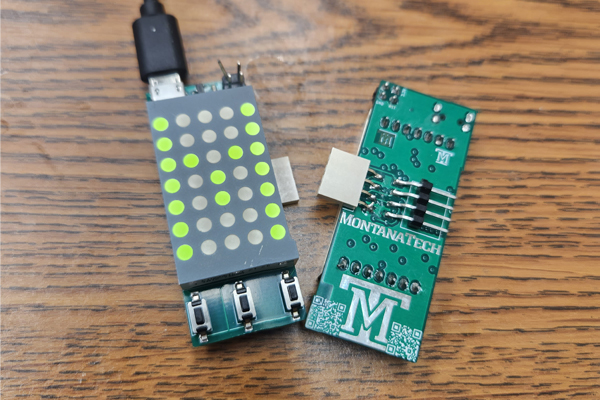Electrical Engineering Department invites high school teachers, students to request free LED binary bar counters

Montana Technological University’s Department of Electrical Engineering is distributing electrical engineering innovation packages to high school teachers, and LED binary bar counters to high school students, as well as hosting interactive sessions on robotics this spring to inspire students to study electrical engineering.
Electrical Engineering Department Head Bryce Hill has distributed nearly 100 binary counters to students. The device is created on a custom Montana Tech-branded circuit board. Students are given information about how to activate and understand the counter. Binary code is the base-2 numbering system that allows machines to store significant amounts of digital information. The counter sent to students allows them to learn about binary code, and also comes with instructions so they can practice programming the counter and change it to suit their own needs. It can count up to 1023.
“It will tell them what number it’s on in decimal. They can type in a number in decimal and it will display,” Hill said. “We provide the code and CAD files of the device, so if they wanted to, they could order their own printed circuit board, buy their own components, and solder their own device, and build their own counter.”
Students can request a counter by clicking this link.
“Students are learning very basic computer and software engineering,” Hill said. “If they crack out the CAD files, they are learning fundamental electronics.”
Students with an aptitude for math, interest in coding or robotics, dream of becoming an inventor, or desire to inquisitively take apart machinery are good candidates for a future in electrical engineering and would enjoy projects with the binary counter, but any student with a STEM focus can be successful.
“We want to get students to a point where they are curious and asking questions,” Hill said. “I want it to be a little bit of a mystery so they ask ‘how do we do that?’”
High school teachers can also request a innovation package with a binary counter to share with students in the classroom, and a pack of stickers featuring electrical engineering pioneer Nikola Tesla.
Teachers and students can also sign up for Spring Tech Day, scheduled for March 8, 2024, where the Electrical Engineering Department will give robotic demonstrations. Students will also learn about employment opportunities in the field of electrical engineering. The Bureau of Labor Statistics notes the 2022 median pay for electrical and electronics engineers was $104,610 per year. Electrical engineers also enjoy a wide variety of different subfields they can work in.
“Electrical engineering is the broadest engineering that exists,” Hill said. “We are a service industry for every other discipline. If you need to put in a mine, you need an electrical engineer. If you want to build the James Webb Space Telescope, and everything from very, very small electronics in telecommunications all the way up to massive power grid systems, everything that involves electrons, you need electrical engineers.”
Students who want to delve deeper into professional opportunities available are encouraged to schedule a tour of campus, which can be tailored to personal interests, including 1-on-1 meetings with faculty and walk throughs of the $1.5 million Schweitzer Engineering Laboratories (SEL) Power Systems Labs. The laboratories are one of the few collegiate power labs in the nation that provide educational experiences with high-voltage systems critical to delivering energy in communities around the world.
To schedule an in-person or virtual campus visit, click here.